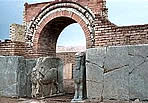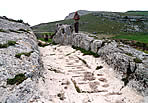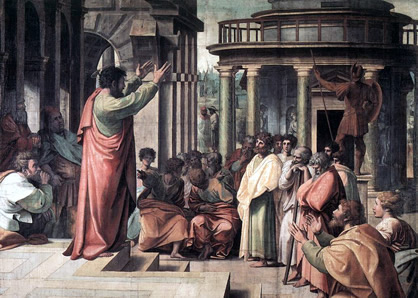Charchemish (Jerablus) II Chron. 35-20, Isa. 10:9, Jer. 46:2
About 38 miles southeast of Gaziantep and 60 miles northeast of
Aleppo (Syria), the ancient city of Charchemish has been located in
ruins along the western bank of the Euphrates River. The
 strategic
city guarded the main ford across the river in antiquity, and now
lay close to the Turkish-Syrian border.
strategic
city guarded the main ford across the river in antiquity, and now
lay close to the Turkish-Syrian border.
The importance of the city as a trade center is demonstrated in that
it was mentioned as far back as the C18 BCE in epigraphy finds at
Mari and Alalakh. It had treaty relationships with Ugarit and
Mitanni, and traded as a Hittite state after about the C14 BCE until
the fall of Pisiris (717 BCE) at the hands of Sargon II of Assyria.

Though the city paid tribute to Asshurbanipal II and Shalmenezzar
III (C9 BCE), Sargon II wanted to take the city because the Persians
treated the city as the strongest of the Hittites.
Pharoah Neco of Egypt (605 BCE) crossed the Jezreel Valley at
Megiddo to move onto Charchemish and take the city. He wanted the
base to contain the Persian advance to the West, and wanted to cut
off the western trade that helped sustain the power in the Persian
Gulf.

The strategy eventually failed as Egypt was defeated in a surprise
entry to the city by the army of Nebucadnezzar II (summer 605 BCE)
that forced a hand to hand fight (Jer. 46:2). The Babylonian
Chronicle captured the details of the battle and the aftermath.
Significant excavations were carried out in for the British Museum
in 1876 to 1879, and again in 1912-14. C. L. Wooley published both
in three volumes called Charchemish . The
 excavations
exposed the outer south and west gates, the wall of the citadel with
two more gates, numerous reliefs and statues of Hittite origin, and
a temple complex.
excavations
exposed the outer south and west gates, the wall of the citadel with
two more gates, numerous reliefs and statues of Hittite origin, and
a temple complex.
Biblical Sites in Turkey List


